Hawaii Palm Trees (With Pictures) – Identification Guide

Hawaii is home to several species of exotic palm trees, including the stunning native Hawaiian palm—Loulu (Pritcharia spp.). Palms are a part of Hawaii’s coastal and mountainous skyline. Tropical palm trees like coconut palms, foxtail palms, and Florida royal palms grace many of Hawaii’s sandy beaches, and their silhouettes look stunning in sunsets. In addition, many native Hawaii palms grow in the mountains at high elevations, giving the unique landscape a distinctly tropical appearance.
Palm trees growing in Hawaii are generally divided into two categories—palms with fan fronds or feather-type leaves. In many cases, it’s possible to identify Hawaiian palms by characteristics like their leaf type, type of trunk, type of palm fruit, and general size.
This article is a guide to identifying many of the diverse palm trees growing in Hawaii. Descriptions and pictures of tropical island palms will help identify varieties of palms growing along Hawaii’s beaches or in the stunning mountain ranges.
Palms for Growing in Hawaii
Hawaii’s tropical climate makes it ideal for palm trees to thrive. Its sandy, loamy soil on the islands’ coastlines provides the perfect conditions for tropical palms. Also, warm temperatures and plenty of moisture are necessary for most palms.
Palms growing in Hawaii should be suitable for USDA growing zones 9 to 13.
Native Hawaii palm trees in the genus Pritchardia are named Loulu and they can be found throughout the islands. Most Loulu palms are found growing naturally in the mountains. However, smaller Hawaiian palms are also popular in landscaping. Therefore, you will often see them in parks, residential gardens, or lining streets.
Other palms you are likely to come across in Hawaii are coconut palms, bottle palms, foxtail palms, bismarck palms, and fishtail palms.
Hawaii Palm Tree Facts
Loulu (Pritchardia spp.) is the palm tree genus native to Hawaii. Native palms generally have palmate leaves, also referred to as fan fronds. These fronds are round leaves with deep pleats forming narrowly pointed leaf tips. The fan leaves of Loulu palms are typically on arching or drooping petioles.
Pritchardia or Loulu palms are single-trunked trees with fan-shaped fronds. The palms range in height from the small Pritchardia remota measuring 16 ft. (5 m) tall to the impressive Pritchardia schattaueri that can grow up to 130 ft. (40 m). However, most Hawaiin palms are medium-sized, averaging between 25 and 60 ft. (7.6 – 18 m) tall.
Native Hawaii trees are typically slow-growing plants. According to some sources, there are around 24 different varieties of native Hawaiian palms found on eight islands.
An interesting fact about Hawaiian palms: Each Hawaiian island has at least one distinct Loulu variety. Some of these are rare, and their habitat can be restricted to individual mountains or valleys.
The non-native palm trees got to Hawaii by early Polynesian travelers. Although coconut palm trees are common throughout the islands’ coastal regions, they were originally carried in boats to Hawaii. At one time, the Loulu palms covered much of the forested areas of the islands before the introduction of non-native palm tree species.
Types of Palm Trees in Hawaii (With Pictures) – Identification Guide
Palm trees are synonymous with warm sunny climates and tropical islands like Hawaii. Apart from the native Pritchardia species, what other types of palm trees are common on the Hawaiian islands? Please read on to find out.
Loulu (Pritchardia spp.) — Hawaii’s Native Palm Trees
Loulu palm trees have a single trunk and are identified by large fan fronds on stalks measuring 2 to 10 ft. (0.6 – 3 m) long. Certain species of Pritchardia have graceful arching branches with pleated round fronds. However, other varieties of native Hawaii palms have drooping or weeping branches.
Like all varieties of palms, Loulu palms produce fruits. These palm fruits are oval or spherical and grow in large clusters under the branches at the tree’s crown. The fruits can measure 0.75” to 2” (2 – 5 cm), depending on the species of palm tree.
Pritchardia remota— A small palm tree endemic to the Hawaiian island Nihoa that typically reaches 13–16 ft. (4–5 m) tall. It has a slim ringed trunk, dense crown with fan-shaped leaves with drooping tips, and a small dark brown or black fruit.
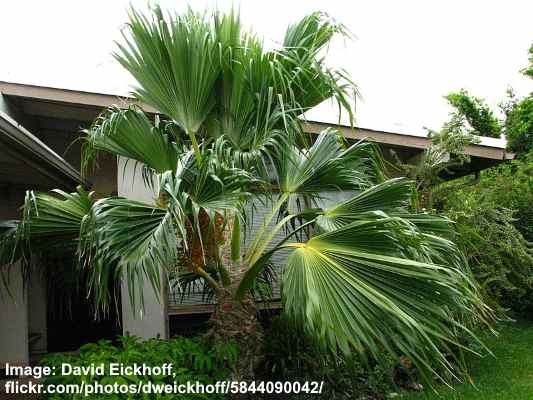
Pritchardia remota
Pritchardia munroi—A short Hawaiian palm growing 16 ft. (5 m) tall. It has drooping fan fronds that cover the entire tree, almost hiding the broad trunk from sight. It is native to dry and moist forests. Native to the Hawaiian islands Molokai and Maui.
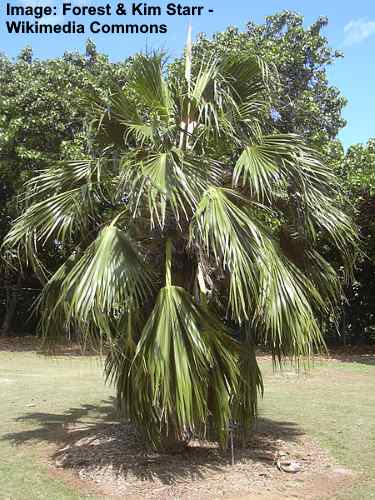
Pritchardia munroi
Pritchardia arecina—A medium-sized Hawaiian palm growing 30 to 50 ft. (9 – 15 m) tall. The large round palmate leaves measure 3 ft. (1 m) long on slightly arching stalks. Native to East Maui.
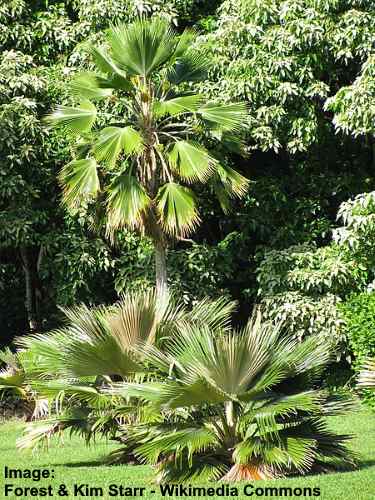
Pritchardia arecina
Pritchardia beccariana—This tall, slender palm is characterized by its smooth, gray stalk and spreading crown of flat fan fronds. The upper fronds extend at right angles from the crown shaft, whereas the lower ones tend to droop. The native palms are found on the eastern slopes of Mauna Loa on the Big Island.
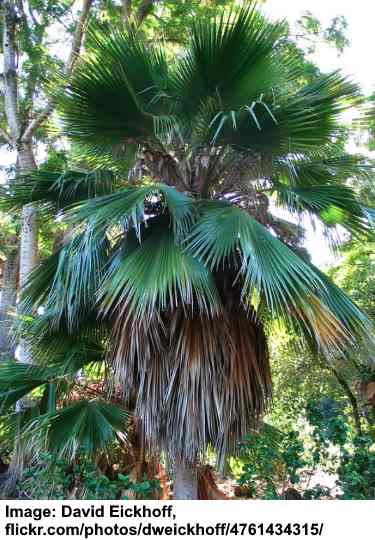
Pritchardia beccariana
Pritchardia glabrata—This slow-growing dwarf Hawaiian palm grows 6.5 to 16 ft. (2 – 5 m) tall. It has an open crown with fan leaves, each measuring about 2 ft. (0.6 m) long. Native to Lanai and West Maui.
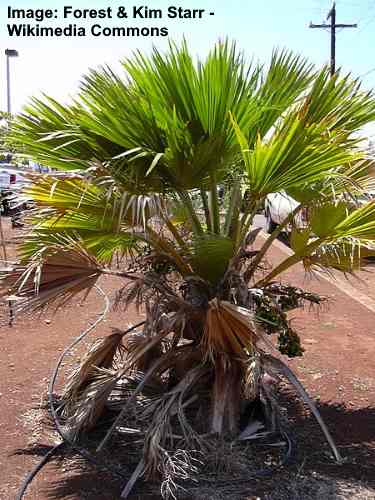
Pritchardia glabrata
Pritchardia lanigera—Native to Mauna Kea and Mauna Loa on the island of Hawaii, this exotic palm plant grows 50 ft. (15 m) tall with large, round fan fronds growing on relatively short petioles.
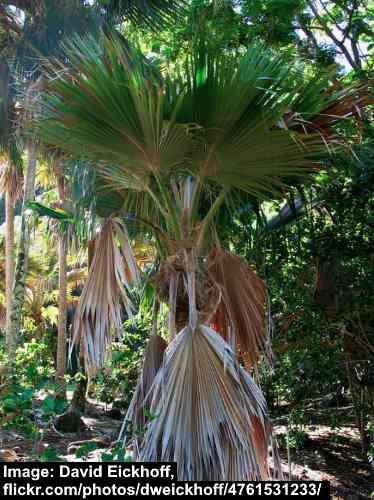
Pritchardia lanigera
Coconut Palm (Cocos nucifera)
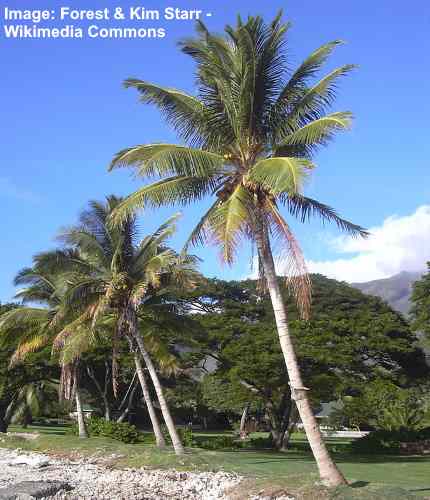
Coconut palms are popular trees in Hawaii and thrive in warm tropical conditions
The coconut palm is one of the most iconic symbols of Hawaii. This tall, stately tree has a single, branchless trunk that is often curved. The tall palm tree features arching green pinnate fronds, fragrant yellow flowers, and palm fruits—the characteristic palm coconuts.
Coconut palm trees were one of the first non-native palms to be brought by hand to the island.
Coconut palms in Hawaii grow 50 to 100 ft. (15 – 30 m) tall and have a characteristic open crown. Throughout the year, the tropical palm blooms with large 4 ft. (1.2 m) long clusters of yellow flowers. These are followed by hard coconuts—large green balls with a fibrous husk covering a woody shell.
Areca Palm (Chrysalidocarpus lutescens or Dypsis lutescens)
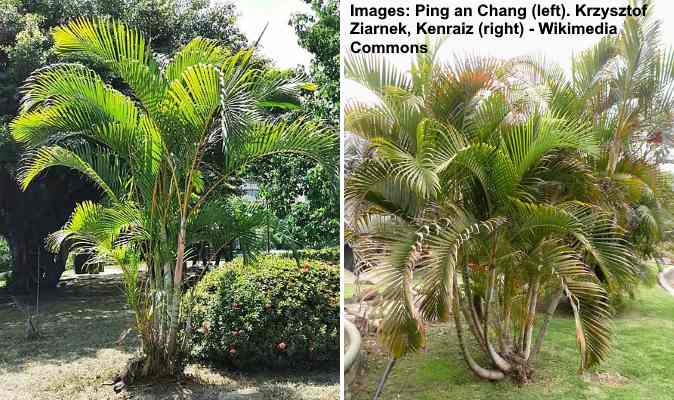
Areca palms are multi-trunked trees that are relatively small and look attractive in Hawaiian landscapes
The areca palm tree is a popular tropical palm due to its bushy evergreen foliage. The lush palm has large feather fronds measuring 5 to 7 ft. (1.5 – 2.1 m) long, each having 90 to 110 strap-like leaflets. The palm blooms in late summer with clusters of bright yellow flowers followed by orange palm fruits.
The multi-stemmed palm tree grows 12 to 30 ft. (3.6 – 9 m) tall and 15 ft. (4.5 m) wide. Other identifying features of the Hawaiian palm are its cane-like yellowish-green ringed stems and curved fronds resembling a butterfly.
Areca palms are one of the most popular palms grown as indoor houseplants.
Bismarck Palm (Bismarckia nobilis)
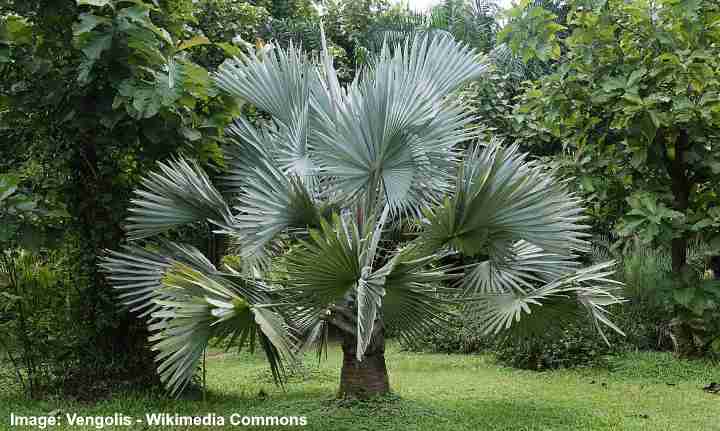
Bismarck palm tree has beautiful silvery gray foliage and looks stunning as a focal point in Hawaii gardens
The Bismarck palm is a majestic tropical palm tree with huge silvery-blue fan-like fronds. The round spiky palm leaves grow in all directions creating an impressive visual display. The stiff fan fronds measure 4 ft. (1.2 m) long and wide. Clusters of brown flowers grow on arching stems under the leaves, followed by oval fruits.
The Bismarck palm is an excellent choice for planting as a specimen tree or lawn tree. Its stout, ragged trunk and attractive canopy create a dramatic statement in a garden landscape.
The Bismarck palm grows 40 to 70 ft. (12 – 21 m) tall and up to 15 ft. (5 m) wide. As well as being popular in Hawaii, the palm tree is a common landscaping palm in California.
MacArthur Palm (Ptychosperma macarthurii)
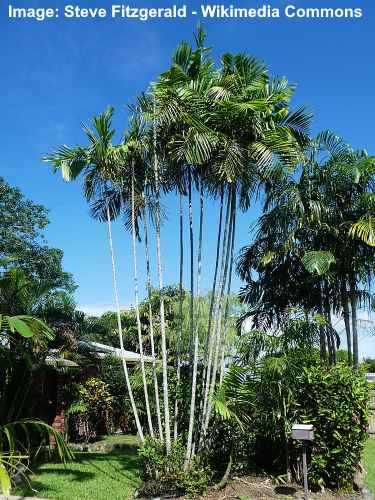
MacArthur palm is identified by multiple tall skinny trunks
The MacArthur palm is a multi-stemmed tree, identified by its multiple tall and slender bamboo-like trunks, green crown shaft, and rounded spiky crown. The palm fronds are feathery and flat and measure 10 ft. (3 m), each with 30 to 80 leaflets. Each stem can have eight to ten leaves creating its irregular canopy.
MacArthur palm tree can grow 22 to 30 ft. (7 – 9 m) tall. Their clumping habit, smooth white-gray trunks swollen at the base, and large clusters of red fruits make this palm easy to identify in Hawaiian landscapes.
Triangle Palm (Dypsis decaryi)
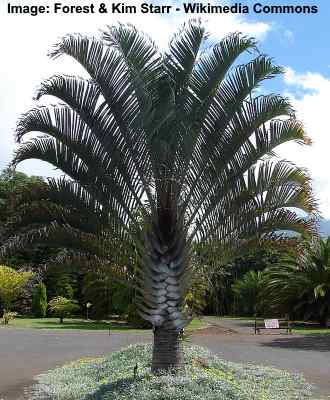
The small triangle palm has pinnate fronds that fan out from a single trunk
The triangle palm is a beautiful palm with an easily identifiable crown, stocky trunk, and creamy-white marble-sized fruits. The beauty of the triangle palm is its arching feather fronds that grow 10 ft. (3 m) long and spray out like a peacock spreading its feathers.
The triangle palm grows 25 to 30 ft. (7 – 9 m) tall and 12 to 15 ft. (3 – 5 m) wide. Perfect for the tropical regions of Hawaii, this palm tree thrives in full sun in USDA zones 10 to 13. Additionally, it withstands drought and high winds.
Blue Latan Palm (Latania loddigesii)

The blue latan palm has an attractive silvery blue foliage and is suitable for Hawaii coastal areas
The blue latan palm tree is characterized by its stunning canopy of stiff silvery-blue fan fronds with red edges. The impressive palm leaves measure 8 ft. (2.4 m) wide and are at the end of petioles measuring 5 ft. (1.5 m) long. Additionally, 6 ft. (1.8 m) flower stalks grow under the leaves, followed by brown fruits measuring 1” (2.5 cm) across.
The blue latan palm grows 20 to 25 ft. (6 – 8 m) tall and 10 to 15 ft. (3 – 5 m) wide. Due to its tolerance to salty air and sandy soil, it’s a popular palm tree in Hawaii’s coastal locations.
Red Sealing Wax Palm (Cyrtostachys renda)
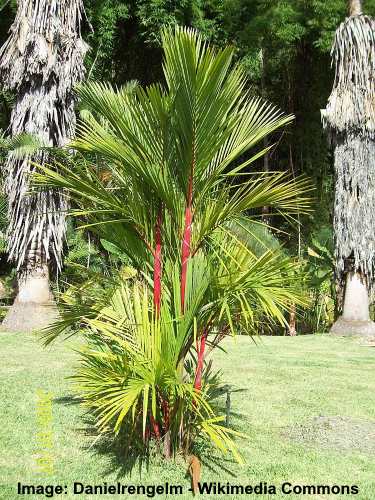
Red sealing wax palm is a small tree with distinctive red leaf stems and is grown in Hawaii warm climate
The red sealing wax palm is one of Hawaii’s most unusual palm trees. This stunning tropical plant is identified by its bright red crown shaft and frond sheaths. Its lush green pinnate fronds measure 4 to 5 ft. (1.2 – 1.5 m) long, and the palm produces small egg-shaped black fruits.
Also called the lipstick palm, this unique palm tree grows 25 to 35 ft. (7 – 11 m) tall, and its crown spreads up to 20 ft. (6 m) wide. The red sealing wax palm can be used as an ideal specimen plant, hedge plant, or screen for a sunny garden in a tropical island landscape.
Alexandra Palm (Archontophoenix alexandrae)
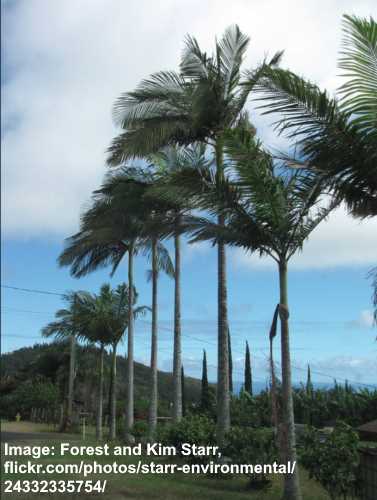
Alexandra palm is a tall tree with a slender trunk suitable for tropical Hawaii landscapes
The Alexandra palm tree is an elegant, tropical palm commonly seen in Hawaiian landscapes. The identifying features of the palm tree are its solitary gray trunk, spreading crown of feather fronds, and huge clusters of red, green, and yellow flowers. Additionally, the trunks are often swollen at the base.
Alexandra palm trees grow 100 ft. (30 m) tall and have a visible green crown shaft measuring 3 ft. (1 m). Its feathery leaves are 15 ft. (4.5 m) long, each containing up to 160 leaflets.
Florida Royal Palm (Roystonea regia)
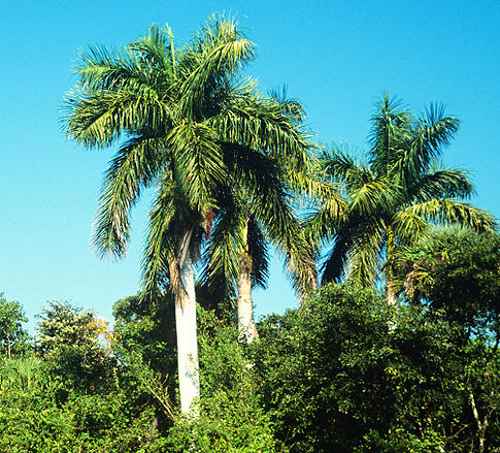
The tall Florida royal palm is common in Southern USA states
The Florida royal palm is a majestic, tall, and slender palm tree that grows 100 ft. (30 m) tall. The identifying features of this imposing palm are its cylindrical gray trunk with large feathery fronds 13 ft. (4 m) long. Additionally, it has large clusters of flowers that develop into violet-blue egg-shaped fruits.
Other distinctive features of the Florida royal palm tree are its smooth green crown shaft, fibrous roots at the trunk’s base, and visible rings around the brownish-gray trunk.
Also called the Cuban royal palm, the royal palm trees are common in Southern California, Texas, Florida, and Hawaii.
Carpentaria Palm (Carpentaria acuminata)
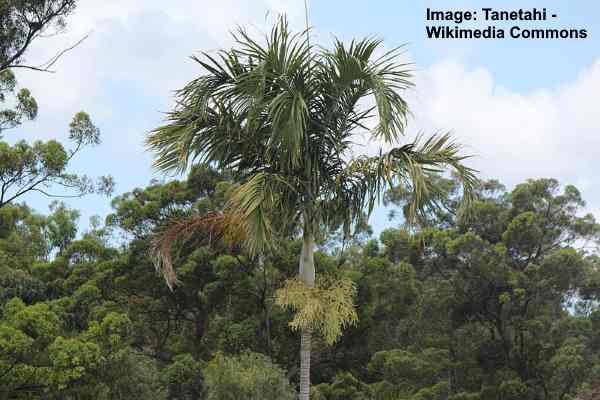
Carpentaria palm is characterized by a slim trunk and can grow very tall
Carpentaria palm is a sun-loving, fast-growing tropical tree commonly seen in Hawaii. The solitary palm has a slender, erect trunk with a crown of large arching feathery fronds. The palm’s fronds measure 10 to 15 ft. (3 – 5 m) long and emerge from a smooth green crown shaft.
This ornamental Carpentaria palm tree has a slender trunk that grows up to 30 to 100 ft. (9 – 30 m) tall and features large, feather-like fronds. The fronds are a bright green color and can grow up to 10 ft. (3 m) long.
Pigafetta filaris
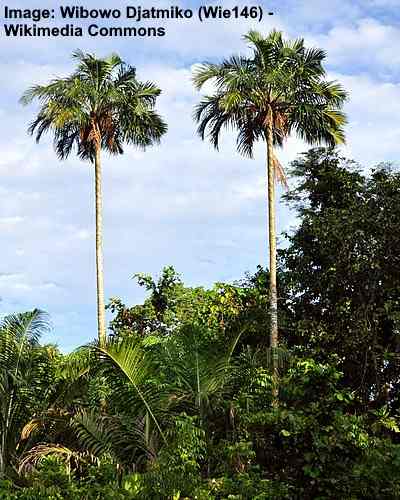
Pigafetta filaris is one of the tallest palms in Hawaii, reaching up to 164 ft. (50 m)
Pigafetta filaris is a stunning very tall palm tree commonly seen growing in gardens and forests in Maui, Hawaii. With its slender trunk and long, feathery fronds, it adds a touch of tropical elegance to any landscape or garden. The majestic palm’s fronds measure 20 ft. (6 m) long, with strap-like leaflets measuring 3 ft. (1 m).
The Pigafetta filaris is a versatile palm tree that thrives in various soil conditions. It’s a fast grower in warm, humid conditions and needs consistently moist soil. These growth features make it ideal for growing in Hawaiian landscapes.
Palmetto Palm Tree (Sabal palmetto)
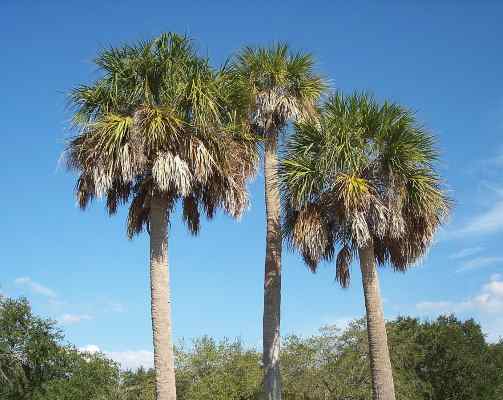
Palmetto is a type of tall and fast growing palm tree
The palmetto palm tree, also known as the cabbage palm, is a beautiful tree often associated with tropical climates such as Hawaii. This tree is known for its tall and slender trunk, topped with a crown of large, fan-shaped fronds with older brown leaves drooping around the trunk that sway gently in the breeze.
An unusual feature is its trunk—smooth at the base and rough nearer the crown. This tropical palm tree grows 40 to 50 ft. (12 – 15 m) tall, and its fan fronds are 6 ft. (1.8 m) long. It’s also a fast-growing palm that annually adds 2 ft. (0.6 m) to its height.
Peach Palm (Bactris gasipaes)
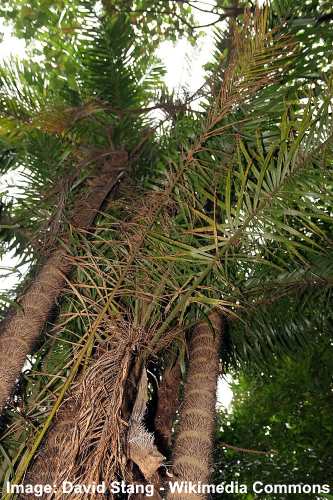
The tropical peach palm can be easily identified by its spiny trunk
The peach palm is a type of exotic sea-island palm tree with an erect, solitary stem and rounded crown of feather fronds. The tropical palm grows 66 ft. (20 m) tall. Its pinnate feathery leaves are 10 ft. (3 m) long at the end of a 3 ft. (1 m) stalk. After flowering, the palm produces edible fruits.
A unique feature of the peach palm is its spiny trunk, with circular rows of stiff black spines.
Although not native to Hawaii, the large palm tree is not invasive and thrives in the local landscape.
Foxtail Palm (Wodyetia bifurcata)
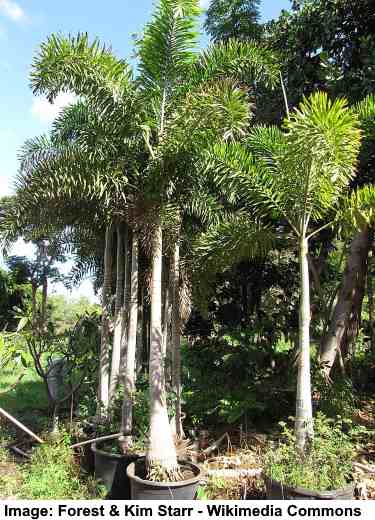
Foxtail palm is a medium sized tree suitable to grow in Southern Florida and Hawaii
The foxtail palm is an attractive tropical plant with unusual plumose fronds, large orange fruits the size of a duck egg, and a solitary, erect trunk. Foxtail palms grow 30 ft. (10 m) tall, and their large, pinnately compound fronds can measure 8 to 10 ft. (2.4 – 3 m) long.
As the name suggests, the plume-like foliage of these palm trees resembles a bushy fox’s tail.
Bottle Palm Tree (Hyophorbe lagenicaulis)
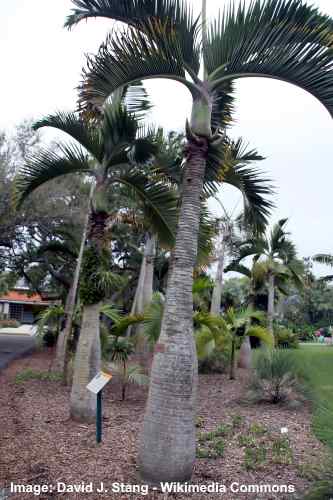
The small ornamental bottle palm tree has a thick short trunk and is suitable for small Hawaiian gardens
The bottle palm tree is an unusual palm common in Hawaiian gardens, landscapes, parks, and along streets. Its identifying feature is the unique trunk that looks like a rounded bottle. The palm has a smooth, green crown shaft and sparsely growing crown of feather fronds. The small palms grow 12 to 15 ft. (3.6 – 5 m) tall.
Because of its intolerance to cold weather, the bottle palm only grows in the United States in southern Florida and Hawaii. In other states, you can grow the attractive palm in containers as long as you protect it from cold and don’t overwater it.
Traveler’s Palm (Ravenala madagascariensis)
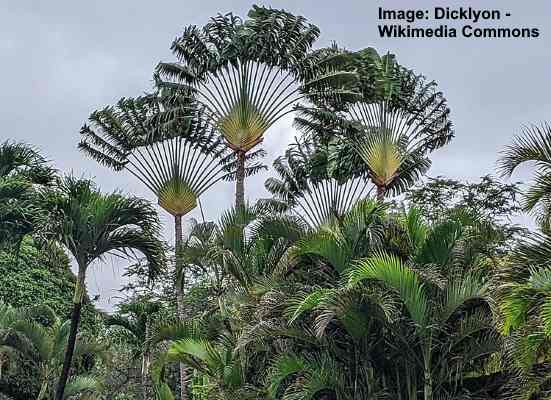
Traveler’s palms have uniquely shaped crowns and are not true palms
The traveler’s palm tree is an eye-catching flowering tree with massive paddle-shaped leaves on long stalks. The recognizable feature of this tree is its unique fan-shaped crown consisting of up to 30 leaves per tree. Each leaf blade measures 5 to 10 ft. (1.5 – 3 m) long and 3 ft. (1 m) wide.
Although called a palm tree, the traveler’s palm is not a “true palm” in the family Arecaceae. Instead, it is related to bird of paradise plants in the genus Strelitzia, and it has similar boat-shaped flowers.
Traveler’s palm thrives in frost-free areas and grows freely in Hawaii, the Florida Keys, and southern California.
Related articles:
